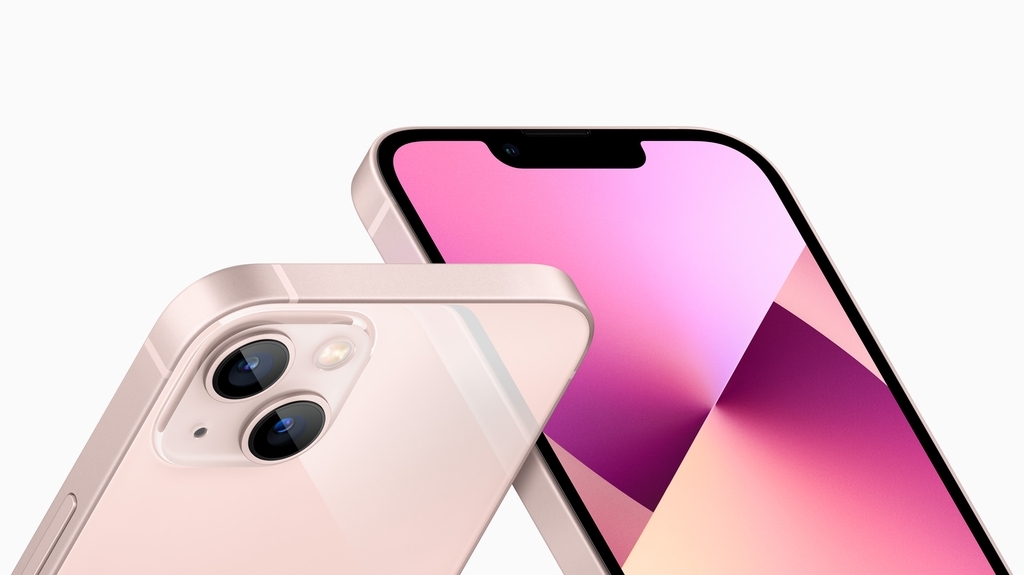 |
This image provided by Apple Inc. on Tuesday, shows the new iPhone 13 smartphone. (Yonhap) |
Apple on Tuesday (local time) unveiled four models of the iPhone 13 series -- the 5.4-inch iPhone 13 mini, the 6.1-inch iPhone 13, the 6.1-inch iPhone 13 Pro and the 6.7-inch iPhone 13 Pro Max.
Apple said its new iPhone family, featuring upgraded camera system and enhanced battery life, will go on sale in South Korea on Oct. 8, two weeks after the company launches the products in more than 30 select countries, including the United States, Britain, Germany, China and Japan.
The prices of iPhone 13 models will be same as their predecessors. The standard iPhone 13 will be sold with a price tag starting at 1.09 million won ($930) here, and the iPhone 13 mini from 950,000 won.
The starting price for the iPhone 13 Pro and the iPhone 13 Pro Max has been set at 1.35 million won and 1.49 million won, respectively.
The 5G-supporting iPhone 13 series will have expanded storage capacity with the Pro lineup offering 1TB variant, in addition to 128GB, 256GB and 512GB models. The iPhone 13 and the iPhone 13 mini doubled the entry-level storage at 128GB, and come with 256GB and 512GB versions.
The iPhone 13 models are powered by Apple's A15 Bionic processor built with the 5-nanometer process to deliver better power efficiency and improved performance.
The A15 Bionic features a new five-core graphics processing unit (GPU) in the Pro lineup, offering up to 50 percent faster graphics performance than its competitors. Its new six-core central processing unit (CPU) also boasts 50 percent faster performance than the competition, Apple said.
When it comes to battery life, the iPhone 13 and the iPhone 13 Pro Max can last up to two and a half hours longer in a day than their predecessors, while the iPhone 13 mini and the iPhone 13 Pro provide up to one and a half hours longer in a day than their predecessors.
For the camera system, Apple said its unique sensor-shift optical image stabilization technology will be applied to all models. Such technology, which stabilizes the sensor instead of the lens, was used only in the iPhone 12 Pro Max.
The iPhone 13 and the iPhone 13 mini come with a new wide camera with 1.7-micron pixels that is equipped with the biggest sensor ever for its dual-rear camera system and captures 47 percent more light.
The iPhone 13 Pro and the iPhone 13 Pro Max with triple-rear camera setup will have a wide shooter with 1.9-micron pixels that provides up to 1.5 times better improvement in low-light situations compared to the iPhone 12 Pro Max.
They also have a new ultra-wide camera with a wider f/1.8 aperture and an enhanced autofocus system to enable macro photography, allowing users to magnify subjects with a minimum focus distance of 2 centimeters.
The new Pro lineup, featuring Super Retina XDR OLED display with ProMotion supporting an adaptive refresh rate from 10Hz to 120Hz, also has a new 77mm telephoto lens, offering a total 6x optical zoom range on the camera system.
For video shooting, Apple introduced "Cinematic mode," which allows users to add a better depth effect with automatic focus changes and background bokeh in video.
In South Korea, Apple hopes the new iPhone 13 series can attract more users against homegrown giant Samsung Electronics Co., which is promoting foldables for the premium market.
Samsung had a dominant share of 73 percent in the South Korean smartphone market in the second quarter, while Apple was the runner-up with a 16 percent share, according to market researcher Counterpoint Research.
Globally, Apple will try to solidify its leadership in the 5G smartphone market. With the iPhone 13 series, Counterpoint Research expected Apple to represent 33 percent of the worldwide 5G handset shipments this year, up from 24 percent a year ago. The global 5G smartphone shipment in 2021 was tipped to reach 605 million units this year. (Yonhap)







